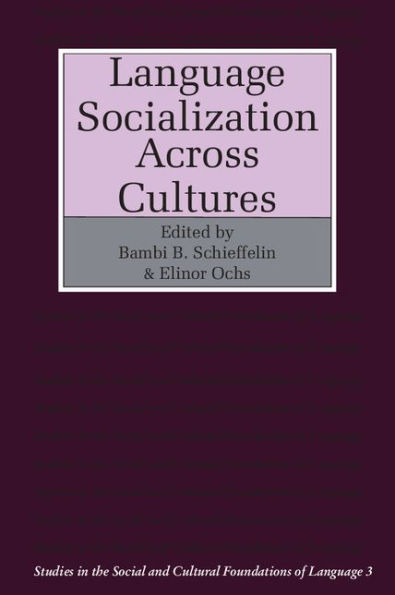Language Socialization across Cultures
Children's aquisition of language and their acquisition of culture are processes that have usually been studied separately. In exploring cross-culturally the connections between the two, this volume provides a new, alternative, integrated approach to the developmental study of language and culture. The volume focuses on the ways in which children are both socialized through language and socialized to use language in culturally specific ways. The contributors examine the verbal interactions of small children with their caregivers and peers in several different societies around the world, showing that these interactions are socially and culturally organized, and that it is by participating in them that children come to understand sociocultural orientations. They emphasize the salient language behaviours of children and others, and show how these are embedded in broader patterns of social behaviour and cultural knowledge. They reveal that various features of discourse - phonological, morpho-syntactic, lexical, pragmatic, and conversational - carry sociocultural information, and that language in use is a major resource for conveying and displaying socio-cultural knowledge. As children acquire language, so they are also acquiring a world view. This innovative approach to the study of language acquisition and socialization will appeal widely to anthropologists, linguists, psychologists, specialists in communication studies, and educationists.
1100946621
Language Socialization across Cultures
Children's aquisition of language and their acquisition of culture are processes that have usually been studied separately. In exploring cross-culturally the connections between the two, this volume provides a new, alternative, integrated approach to the developmental study of language and culture. The volume focuses on the ways in which children are both socialized through language and socialized to use language in culturally specific ways. The contributors examine the verbal interactions of small children with their caregivers and peers in several different societies around the world, showing that these interactions are socially and culturally organized, and that it is by participating in them that children come to understand sociocultural orientations. They emphasize the salient language behaviours of children and others, and show how these are embedded in broader patterns of social behaviour and cultural knowledge. They reveal that various features of discourse - phonological, morpho-syntactic, lexical, pragmatic, and conversational - carry sociocultural information, and that language in use is a major resource for conveying and displaying socio-cultural knowledge. As children acquire language, so they are also acquiring a world view. This innovative approach to the study of language acquisition and socialization will appeal widely to anthropologists, linguists, psychologists, specialists in communication studies, and educationists.
64.0
In Stock
5
1

Language Socialization across Cultures
288
Language Socialization across Cultures
288Paperback(New Edition)
$64.00
64.0
In Stock

Product Details
| ISBN-13: | 9780521339193 |
|---|---|
| Publisher: | Cambridge University Press |
| Publication date: | 02/27/1987 |
| Series: | Studies in the Social and Cultural Foundations of Language , #3 |
| Edition description: | New Edition |
| Pages: | 288 |
| Product dimensions: | 5.98(w) x 8.98(h) x 0.94(d) |
From the B&N Reads Blog
